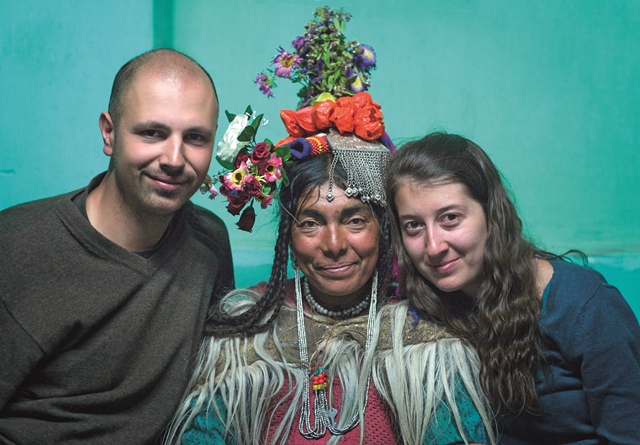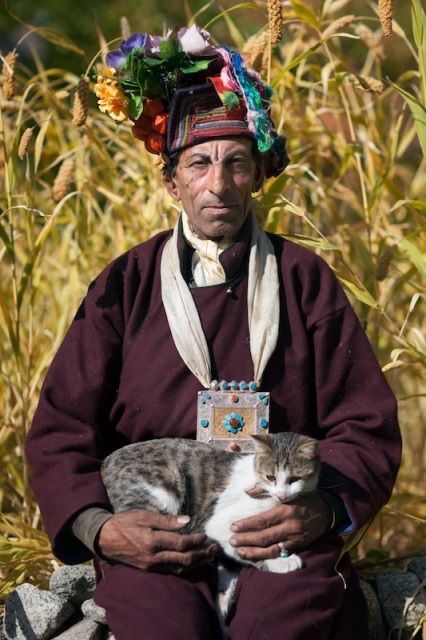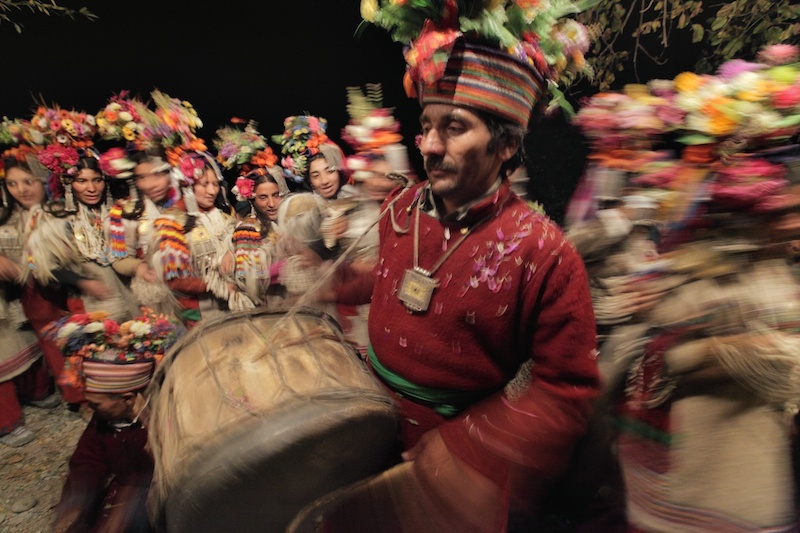The colourful people
Buddhist dards from the Himalayas start melting into global monotony
Only 2000 people at the border
between India and Pakistan. Between Buddhism and Islam. Between imagination and reality. Between the past and the future. These are the Buddhist dards from the Western Himalayas. An almost
untouched community with its unique beliefs, which will ,however, melt very soon into the unified world sea. Alexander Bogdanov and Proletina Robova spend a few months in the last 2 years among the
dards. They manage to capture through their photographic camera, videocamera and their own senses the incredible colour of the three villages,that gave shelter to these colourful people. We are
lucky they will tell us their countless interesting stories.

Dards have radically different anthropological marks and culture from the other people in the region. They have their own language, which is not spoken anywhere else in the world. Although they adopted Buddhism two centuries ago, they still preserve many of their ancient beliefs and rituals. The rest of the natives call them 'Brog-pa', which means 'mountaineers'. The separation of Pakistan from India left some of them beyond the border, they adopted Islam and their traditions faded away. Until the mid-70s of the 20th century, this part of the world stayed remote from the rest of the world. It soon opened its doors for tourists, who brought modernity.
THE COLORFUL PEOPLE
Luckily, many of the authentic traditions are preserved today – the fire of the ancient culture smoulders with the last older dards. Unfortunately, one day it will die out since the young cannot and do not want to take care of it. Lots of beliefs, songs and rituals will disappear with the old generation.
Alexander and Proletina aim at catching this flame, when they start their trip to the three villages. The afternoon, in which they meet the dards for the first time, welcomes them beautifully – there are trees everywhere, most of which are apricot trees. Loaded with the sweetest apricots they have ever tasted. Most tourists stay here only one day, but Alexander and Proletina decided this place attracts them. Ever since, they often return to their hosts, while their trips turn into a project. The Bulgarians are perhaps the first scholars, who systematically begin to document their traditions, songs, feasts, rituals, which would be forgotten soon.
A special place in the specific dards' culture is assigned to the variegated flowers, which can be found anywhere – in yards, in houses and mainly on their traditional hats. Even
most of their songs are devoted to flowers- women from the village send them to shepherds , who on their part send other flowers back. Will the flowers from their costumes, however, be replaced with artificial ones?
Brog-pa are Indo-Aryan – their features resemble the Mediterranean ones and have nothing to do with the much swarthier people around. There are many legends about them – for instance, that they are descendants of the left in the region commanders of Alexander the Great. There are others that say that thanks to their reputation of being pure Aryans, there were German women sent here when Hitler was in power. According to the Bulgarians, both legends are far from reality. It is a fact, however, that dards are...
read more in issue 1/2013 of Magazine Ossem

LET'S HONOUR LHA!
What makes Brog-pa really unique is their specific mythology. As it became clear, Buddhism wheels within much older traditions here. The highest place is taken by 360 deities, called 'lha', which inhabit the high parts of the mountains. Dards treat them not like deities, but rather a separate class of creatures in nature, together with humans and
animals. There are supreme only with their power to influence people. Except for them, dards also worship water spirits, called 'lu', which inhabit clear springs. A third class of deities is related to home and the Earth – they are embodied by a stone, called 'sabdak', which stands behind the fireplace.
There are many more deities, which surprisingly remind of popular ancient Greek or Roman gods, but today do not fall into the tack ground.
According to the dards, world history is much more beautiful than we think. The people and lha lived together in peace and harmony once.
Every single day was filled with feasts, songs and dances. Infinite! If you see a deity dancing today and watch it for 5 minutes, there would be 5 human lives flown out.
Unfortunately, everything changed at once. One of the men tried to....
read more in issue 1/2013 of Magazine Ossem
The interviews of the two Bulgarians show that dards think of their past as if it is a magic. They believe they were stronger, taller and had long beards. They lived to 150 years! According to our travellers, the older Brog-pa look taller. Wisdom and sorrow are evident from the written words:
'We grow down, at the end we will become so small that we will sit on goat dung'.

WITH THOUGHT OF MAGIC
All feasts here are connected with the magical past. The most important relationship is the one between deities and the wonderful times, when they lived together with people. In their memory, they invite mythical creatures to the feast, cerestain they will come only if they welcome them with the expected cleanness…
Brog-pa heal two types of illnesses through shaman rituals – physical, which are caused by pollution and psychical – result of evil eyes or magic. Dards treat magic as if it is an evil thought, which takes the form of an animal if it stays in the person for too long – a lizard, a bee, a bird. One of the shamans tells a story of how he once took a bee out of the head of a mentally ill person.
The full article for the colorful people and their old sacret rituals is in issue 1/2013 Magazine Ossem.

Dards have radically different anthropological marks and culture from the other people in the region. They have their own language, which is not spoken anywhere else in the world. Although they adopted Buddhism two centuries ago, they still preserve many of their ancient beliefs and rituals. The rest of the natives call them 'Brog-pa', which means 'mountaineers'. The separation of Pakistan from India left some of them beyond the border, they adopted Islam and their traditions faded away. Until the mid-70s of the 20th century, this part of the world stayed remote from the rest of the world. It soon opened its doors for tourists, who brought modernity.
THE COLORFUL PEOPLE
Luckily, many of the authentic traditions are preserved today – the fire of the ancient culture smoulders with the last older dards. Unfortunately, one day it will die out since the young cannot and do not want to take care of it. Lots of beliefs, songs and rituals will disappear with the old generation.
Alexander and Proletina aim at catching this flame, when they start their trip to the three villages. The afternoon, in which they meet the dards for the first time, welcomes them beautifully – there are trees everywhere, most of which are apricot trees. Loaded with the sweetest apricots they have ever tasted. Most tourists stay here only one day, but Alexander and Proletina decided this place attracts them. Ever since, they often return to their hosts, while their trips turn into a project. The Bulgarians are perhaps the first scholars, who systematically begin to document their traditions, songs, feasts, rituals, which would be forgotten soon.
A special place in the specific dards' culture is assigned to the variegated flowers, which can be found anywhere – in yards, in houses and mainly on their traditional hats. Even
most of their songs are devoted to flowers- women from the village send them to shepherds , who on their part send other flowers back. Will the flowers from their costumes, however, be replaced with artificial ones?
Brog-pa are Indo-Aryan – their features resemble the Mediterranean ones and have nothing to do with the much swarthier people around. There are many legends about them – for instance, that they are descendants of the left in the region commanders of Alexander the Great. There are others that say that thanks to their reputation of being pure Aryans, there were German women sent here when Hitler was in power. According to the Bulgarians, both legends are far from reality. It is a fact, however, that dards are...
read more in issue 1/2013 of Magazine Ossem

LET'S HONOUR LHA!
What makes Brog-pa really unique is their specific mythology. As it became clear, Buddhism wheels within much older traditions here. The highest place is taken by 360 deities, called 'lha', which inhabit the high parts of the mountains. Dards treat them not like deities, but rather a separate class of creatures in nature, together with humans and
animals. There are supreme only with their power to influence people. Except for them, dards also worship water spirits, called 'lu', which inhabit clear springs. A third class of deities is related to home and the Earth – they are embodied by a stone, called 'sabdak', which stands behind the fireplace.
There are many more deities, which surprisingly remind of popular ancient Greek or Roman gods, but today do not fall into the tack ground.
According to the dards, world history is much more beautiful than we think. The people and lha lived together in peace and harmony once.
Every single day was filled with feasts, songs and dances. Infinite! If you see a deity dancing today and watch it for 5 minutes, there would be 5 human lives flown out.
Unfortunately, everything changed at once. One of the men tried to....
read more in issue 1/2013 of Magazine Ossem
The interviews of the two Bulgarians show that dards think of their past as if it is a magic. They believe they were stronger, taller and had long beards. They lived to 150 years! According to our travellers, the older Brog-pa look taller. Wisdom and sorrow are evident from the written words:
'We grow down, at the end we will become so small that we will sit on goat dung'.

WITH THOUGHT OF MAGIC
All feasts here are connected with the magical past. The most important relationship is the one between deities and the wonderful times, when they lived together with people. In their memory, they invite mythical creatures to the feast, cerestain they will come only if they welcome them with the expected cleanness…
Brog-pa heal two types of illnesses through shaman rituals – physical, which are caused by pollution and psychical – result of evil eyes or magic. Dards treat magic as if it is an evil thought, which takes the form of an animal if it stays in the person for too long – a lizard, a bee, a bird. One of the shamans tells a story of how he once took a bee out of the head of a mentally ill person.
The full article for the colorful people and their old sacret rituals is in issue 1/2013 Magazine Ossem.



